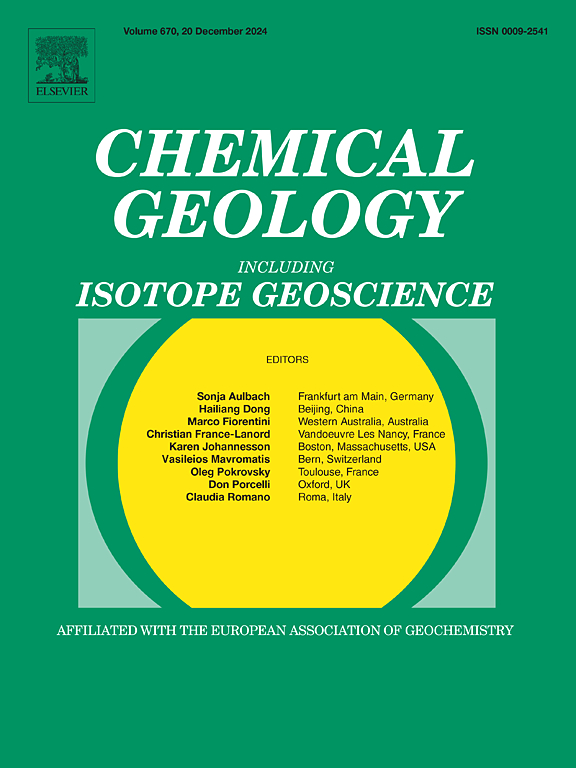更新世-全新世沉积记录中相对海平面变化调控的微生物硫酸盐还原:来自英国苏格兰Duart湖的启示
IF 3.6
2区 地球科学
Q1 GEOCHEMISTRY & GEOPHYSICS
引用次数: 0
摘要
在英国苏格兰西北部阿辛特沿海地区的杜阿尔特湖附近发现了一个更新世-全新世年龄的沉积物岩心,为快速变化的环境条件下硫化铁(黄铁矿)硫同位素组成与有机硫之间的关系提供了新的认识。自晚冰期以来,Duart湖局部海洋连通性的变化受到两个基本地球表面过程之间的竞争驱动:末次盛冰期以来冰川融水贡献导致的海平面上升和冰川均衡反弹导致的相对海平面下降。这些沉积过程已被记录下来,通过岩性、微化石组合、元素分析和同位素测量进行了评估。在过去的17年中,杜瓦特湖经历了从(1)海洋条件(冰川消融引起的海平面上升超过冰川均衡反弹)到(2)非海洋条件(均衡反弹引起的陆地隆起超过海平面上升),再到(3)海洋条件(海平面上升的贡献超过均衡反弹),然后是(4)咸水条件(海平面上升的贡献减少而冰川均衡上升继续)。目前,海洋淹没仅限于潮汐周期的一部分。本文章由计算机程序翻译,如有差异,请以英文原文为准。
Microbial sulfate reduction regulated by relative sea level change in a Pleistocene – Holocene sedimentary record: Insights from Loch Duart, Scotland, UK
A Pleistocene–Holocene-aged sediment core recovered near Loch Duart, located in the coastal Assynt region of NW Scotland, UK, provides new insight into the relationship between the sulfur isotope composition of iron sulfides (pyrite) and organic sulfur under rapidly changing environmental conditions. Since the Late Glacial period, shifts in local marine connectivity at Loch Duart have been driven by the competition between two fundamental Earth surface processes: eustatic sea level rise due to post-glacial meltwater contributions since the Last Glacial Maximum and relative sea level (RSL) fall associated with glacial isostatic rebound. These processes, imprinted on the sedimentary record, have been evaluated via lithology, microfossil assemblages, elemental analysis, and isotopic measurements. Over the last 17 kyr, Loch Duart has transitioned from (1) marine conditions, when eustatic rise due to deglaciation exceeded glacial isostatic rebound, to (2) non-marine conditions, where land uplift caused by isostatic rebound exceeded eustatic rise, to (3) marine conditions, as the eustatic contribution outpaced isostatic rebound, followed by (4) brackish-water conditions, as the eustatic contribution reduced while glacial isostatic uplift continued, with marine inundation limited to part of the tidal cycle at the present day.
Here, we evaluate marked perturbations in the local sulfur (S) cycle related to the aforementioned environmental changes. The marine interval coincides with relatively stable and low δ34Ssulfide values (average ∼ −27.2 ‰), the non-marine interval records an abrupt positive δ34Ssulfide excursion of over 30 ‰ (average ∼ 9 ‰), and the brackish interval preserves intermediate values (average ∼ −16.2 ‰). The δ34Sorg values shift sympathetically with δ34Ssulfide, although the magnitude of δ34Sorg change is nominal by comparison, particularly during the transition from freshwater to marine facies. As expected, marine and brackish sections preserve higher δ34Sorg values than coeval δ34Ssulfide. Interestingly, this relationship is reversed in the freshwater facies, where sulfides are 34S-enriched relative to organic S by as much as 20 ‰, suggesting that RSL modulates the isotopic composition of non-pyrite phases in the bulk S pool. We hypothesize that this inverse relationship (δ34Sorg < δ34Ssulfide) may arise from a spatial decoupling of pyrite and organic S formation within the water column and/or sediments in a system with low sulfate concentrations. Evaluating shifts in the local S-cycle associated with RSL changes allows for a novel comparison between S and osmium isotope records, demonstrating that these proxies may have joint applications for paleoenvironmental investigations in shallow coastal systems. We offer new perspectives on the interplay between eustasy, RSL, and the S-cycle by assessing these relationships in a coastal isolation basin.
求助全文
通过发布文献求助,成功后即可免费获取论文全文。
去求助
来源期刊

Chemical Geology
地学-地球化学与地球物理
CiteScore
7.20
自引率
10.30%
发文量
374
审稿时长
3.6 months
期刊介绍:
Chemical Geology is an international journal that publishes original research papers on isotopic and elemental geochemistry, geochronology and cosmochemistry.
The Journal focuses on chemical processes in igneous, metamorphic, and sedimentary petrology, low- and high-temperature aqueous solutions, biogeochemistry, the environment and cosmochemistry.
Papers that are field, experimentally, or computationally based are appropriate if they are of broad international interest. The Journal generally does not publish papers that are primarily of regional or local interest, or which are primarily focused on remediation and applied geochemistry.
The Journal also welcomes innovative papers dealing with significant analytical advances that are of wide interest in the community and extend significantly beyond the scope of what would be included in the methods section of a standard research paper.
 求助内容:
求助内容: 应助结果提醒方式:
应助结果提醒方式:


